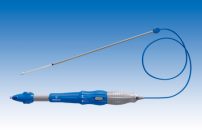Courtesy of Dr. Carlos Fava. Since the beginnings of transcatheter aortic valve replacement (TAVR) back in 2002, this strategy has gained considerable ground, encompassing not only inoperable or high-risk patients but also those at medium and low risk. Additionally, it came to include patients with failed bioprostheses. The most common reason for surgery was paravalvular leak,…
2° Educational Meetings ProEducar-SOLACI | Aortic Valve Implantation. Step by Step. Complications
We are interested in your opinion. Please, leave your comments, thoughts, questions, etc., below. They will be most welcome.
After 8-year Followup, Good News for the Self Expandable Valve
As the transcatheter aortic valve replacement (TAVR) gains ground in lower risk populations and with better survival rate, concern over its durability has grown. This study brings us data and good news on the first-generation self-expandable valve after quite a long follow up. It included 990 inoperable or high-risk patients treated with CoreValve in 8…
Post TAVR Regression of Ventricular Mass
This study looked at patients with moderate to severe left ventricular hypertrophy and aortic stenosis treated with transcatheter aortic valve replacement (TAVR). Patients with reduced hypertrophy had lower mortality and fewer hospitalizations at 5 years. It included all moderate to severe risk patients with ventricular hypertrophy undergoing TAVR in the studies and registries PARTNER (I,…
EuroPCR 2020 | Aortic Valve in Valve in the Long Term
The outcomes of this work are important to plan valve replacement with the largest possible prosthesis allowed by patient anatomy in the index procedure. As a worldwide trend, increasingly more patients are receiving bioprostheses, which have improved a lot but still tend to become deteriorated and require a valve-in-valve procedure if the patient is no…
EuroPCR 2020 | CLASP: New Device for Mitral Repair with at One Year Follow Up
The CLASP looked into patients treated with the new device for transcatheter mitral repair called PASCAL and showed low complications rate, high survival rate, significant mitral regurgitation reduction and improved quality of life at one year. In July 2019 we published on our web page the 30 year outcomes of the PASCAL device () which…
EuroPCR 2020 | EVOQUE: New Transcatheter Mitral Valve Replacement System, Promises at Short Term and Future Hope
Transeptal transcatheter mitral valve replacement offers a less invasive alternative vs. surgery and with fewer anatomical limitations than transcatheter repair (e.g. MitraClip) in patients with severe mitral valve failure. The first patients treated with the new system EVOQUE were included between September 2018 and October 2019 and its outcomes were presented at the virtual EuroPCR…
Contained Annulus Rupture after TAVR: What Should We Do?
Courtesy of Dr. Carlos Fava. Aortic annulus rupture is a catastrophic event that presents in nearly 0.9% of cases, but there is another entity called contained annulus rupture, associated to oversized devices and annulus calcification and diagnosed with CT angiography, with up to 5% frequency. 1602 patients from the ENCORE registry were analyzed. 21 of…
Self-Expanding Valve vs. Balloon-Expandable Valve, Randomized, Head to Head
The “arms race”among transcatheter valves has been vertiginous. By the time we received the mid- or long-term outcomes of studies focused on a given valve, we were already using its next generation in clinical practice. As a result, there is little information addressing which valve is the best. Nowadays, this “arms race” has reached a…
Frailty and Bleeding: Impact on Aortic Valve Replacement
Courtesy of Dr. Carlos Fava. We are well aware that both transcatheter aortic valve replacement (TAVR) and surgical valve replacement (SAVR) generate bleeding (15% to 22% for TAVR and 22% to 44% for SAVR). Frail patients constitute a particular group. These have not yet been assessed as to the real risk they run and mortality…
Leaflet Thickening and Immobility in Evolut Low Risk
Leaflet thickening and immobility caused by thrombosis have been reported for both surgical and transcatheter bioprostheses. This phenomenon is diagnosed through hypoattenuation, thickening, and lack of motion, as observed through computed tomography (CT) imaging. The incidence and, especially, the clinical implications of this phenomenon remain unclear, but they are of great interest, particularly in a…









